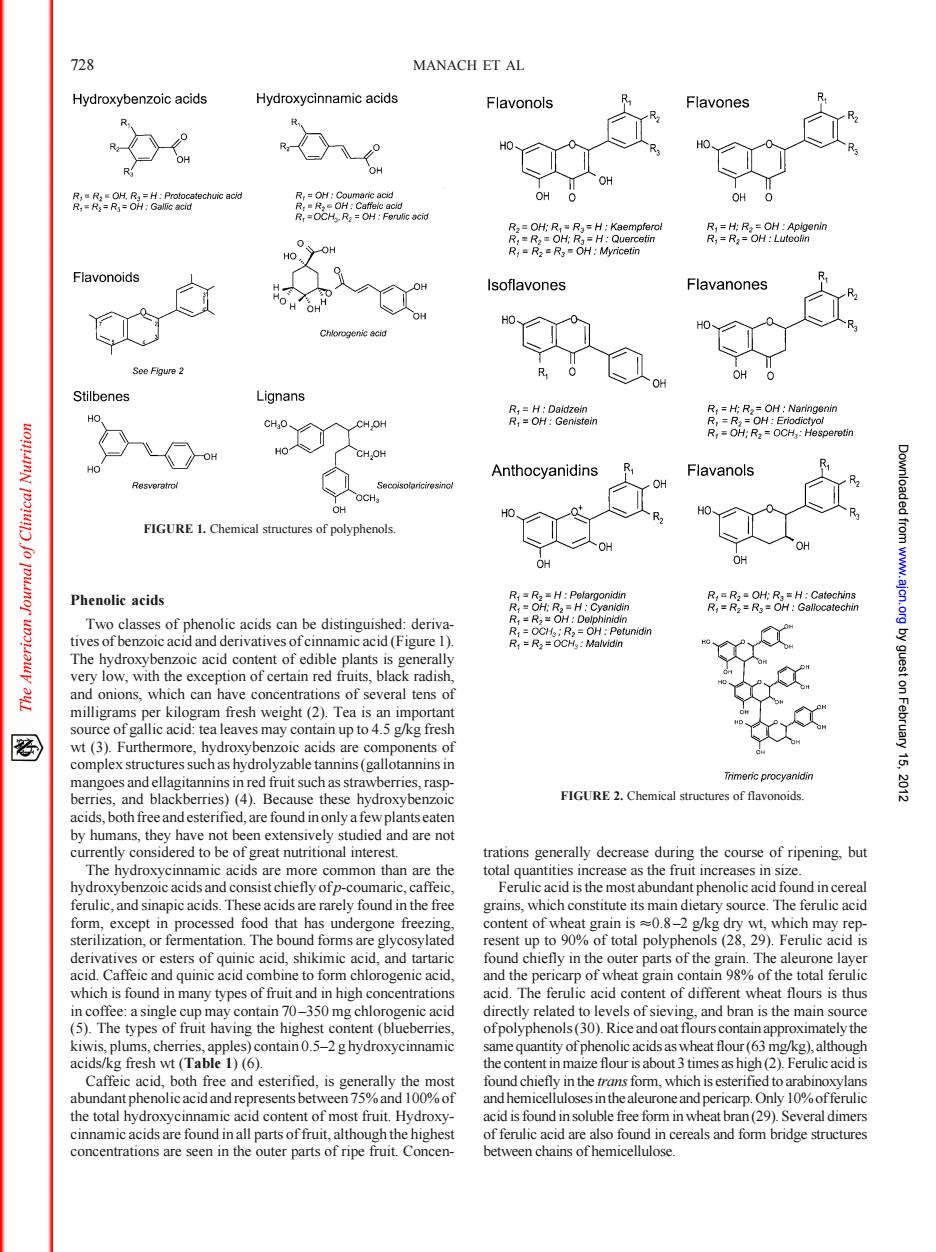正在加载图片...

728 MANACH ET AL Hydroxybenzoic acids Hydroxycinnamic acids "o R:及8eos 骨 及 尽:传oegm Flavonoids Isoflavones See Flpure 2 。 Stilbenes Lignans R:6:0aee Anthocyanidins R FIGURE 1.Chemical sture of polyphenos. Phenolic acids 及R:8t8 The hvdroxy zoic acid content of edible plants with milligrams Feb allic aci t such asst asp Y15.2012 FIGURE 2.Chemical structures of flavonoids. and are no rations ge rease during the course of ripening but crease as the ftutincrcascsintC ids are r rely found in the free undergone free acid.Catfeircandquimic cid combine to form chlorogenic aci a singl contain 70-350m nic acid and bran is the mn ofpolyphenols(3 loat f tely th the total hydroxycinnamic acid content of most fruit.Hydroxy- acid wheat rn() hough the hihest Cfceteaidclecndnereasandomtidencturs I paPhenolic acids Two classes of phenolic acids can be distinguished: derivatives of benzoic acid and derivatives of cinnamic acid (Figure 1). The hydroxybenzoic acid content of edible plants is generally very low, with the exception of certain red fruits, black radish, and onions, which can have concentrations of several tens of milligrams per kilogram fresh weight (2). Tea is an important source of gallic acid: tea leaves may contain up to 4.5 g/kg fresh wt (3). Furthermore, hydroxybenzoic acids are components of complex structures such as hydrolyzable tannins (gallotannins in mangoes and ellagitannins in red fruit such as strawberries, raspberries, and blackberries) (4). Because these hydroxybenzoic acids, both free and esterified, are found in only a few plants eaten by humans, they have not been extensively studied and are not currently considered to be of great nutritional interest. The hydroxycinnamic acids are more common than are the hydroxybenzoic acids and consist chiefly of p-coumaric, caffeic, ferulic, and sinapic acids. These acids are rarely found in the free form, except in processed food that has undergone freezing, sterilization, or fermentation. The bound forms are glycosylated derivatives or esters of quinic acid, shikimic acid, and tartaric acid. Caffeic and quinic acid combine to form chlorogenic acid, which is found in many types of fruit and in high concentrations in coffee: a single cup may contain 70–350 mg chlorogenic acid (5). The types of fruit having the highest content (blueberries, kiwis, plums, cherries, apples) contain 0.5–2 g hydroxycinnamic acids/kg fresh wt (Table 1) (6). Caffeic acid, both free and esterified, is generally the most abundant phenolic acid and represents between 75% and 100% of the total hydroxycinnamic acid content of most fruit. Hydroxycinnamic acids are found in all parts of fruit, although the highest concentrations are seen in the outer parts of ripe fruit. Concentrations generally decrease during the course of ripening, but total quantities increase as the fruit increases in size. Ferulic acid is the most abundant phenolic acid found in cereal grains, which constitute its main dietary source. The ferulic acid content of wheat grain is 0.8–2 g/kg dry wt, which may represent up to 90% of total polyphenols (28, 29). Ferulic acid is found chiefly in the outer parts of the grain. The aleurone layer and the pericarp of wheat grain contain 98% of the total ferulic acid. The ferulic acid content of different wheat flours is thus directly related to levels of sieving, and bran is the main source of polyphenols (30). Rice and oat flours containapproximatelythe same quantity of phenolic acids as wheat flour (63 mg/kg), although the content in maize flour is about 3 times as high (2). Ferulic acid is found chiefly in the transform, which is esterified to arabinoxylans andhemicellulosesinthealeuroneandpericarp.Only10%offerulic acid is found in soluble free form in wheat bran (29). Several dimers of ferulic acid are also found in cereals and form bridge structures between chains of hemicellulose. FIGURE 1. Chemical structures of polyphenols. FIGURE 2. Chemical structures of flavonoids. 728 MANACH ET AL by guest on February 15, 2012 www.ajcn.org Downloaded from